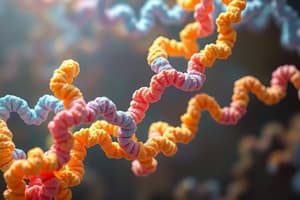Podcast
Questions and Answers
Which elements are present in proteins?
Which elements are present in proteins?
- Carbon, hydrogen, nitrogen
- Carbon, nitrogen, oxygen
- Carbon, hydrogen, oxygen, nitrogen (correct)
- Carbon, hydrogen, oxygen
What are the building blocks of proteins?
What are the building blocks of proteins?
- Carbohydrates
- Amino acids (correct)
- Fatty acids
- Nucleic acids
How are amino acids linked together in proteins?
How are amino acids linked together in proteins?
- By covalent bonds
- By hydrogen bonds
- By peptide bonds (correct)
- By ionic bonds
What is the term for a chain of three amino acids joined together?
What is the term for a chain of three amino acids joined together?
What is the difference between essential and non-essential amino acids?
What is the difference between essential and non-essential amino acids?
Flashcards are hidden until you start studying
Study Notes
Protein Composition
- Proteins are composed of carbon, hydrogen, oxygen, nitrogen, and sometimes sulfur
- These elements are the building blocks of proteins
Amino Acids
- Amino acids are the building blocks of proteins
- There are 20 different amino acids that the human body uses to build proteins
Peptide Bonds
- Amino acids are linked together in proteins through peptide bonds
- Peptide bonds are formed through a condensation reaction, releasing water
- This bond is strong and requires energy to break
Tripeptide
- A chain of three amino acids joined together is called a tripeptide
Essential and Non-Essential Amino Acids
- Essential amino acids cannot be synthesized by the human body and must be obtained through diet
- Non-essential amino acids can be synthesized by the human body from other amino acids
- There are 9 essential amino acids and 11 non-essential amino acids
Studying That Suits You
Use AI to generate personalized quizzes and flashcards to suit your learning preferences.



